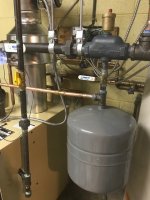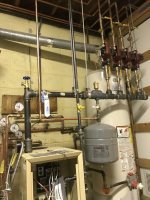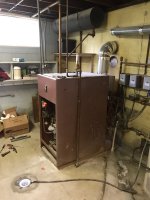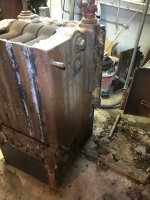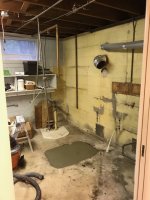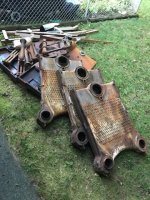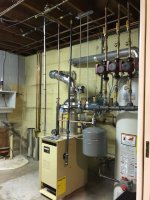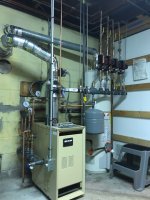A heat load of 65K is a lot for a 2500' house, even with a lot of window
. Have you verified that load number by correlating fuel use against heating degree-day data from a nearby weather station? If you're willing to share wintertime meter readings I can walk you through that here. Use +4F as the
99% outside design temp (half way between Flint's +3F and Detroit's +5F), which would be close enough.
At an entering water temp of 180F, return temp of 160F (average water temp = 170F) fin tube baseboard puts out about 500 BTU per linear foot, so with 140' of baseboard the most it can emit is 70,000 BTU/hr, which is only 1.08 more than your heat load estimate. If your load is REALLY 65K it means it wouldn't be able to keep up during extended cold snaps and it would be quite cold indoors during Polar Vortex disturbance deep cold snaps.
The biggest boiler that makes any sense at all for that radiation would have an output of ~70,000 BTU/hr. A boiler bigger than that won't heat the place any better- it would just cycle on/off a lot more. If your heat load is actually 50,000 BTU/hr, that would be perfectly right-sized per ASHRAE's 1.4x oversizing above the 99% design temp load. (If your actual heat load (as measured by fuel use) is much lower, it will be more comfortable to go a bit lower on the boiler size.) Among the CGa lineup the closest to the "correct" size would be the CGa-4, which has a DOE output of 88,000 BTU/hr, and an I=B=R net of 77,000 BTU/hr. The next step down would be the CGa-3 which puts out 59,000 BTU/hr (DOE), or 51,000 BTU/hr (IBR).
If the boiler is inside the pressure and thermal envelope of the house (rather than out in an garage on the other side of an insulated wall or something) the DOE number is the most relevant, and that's the only number that would be relevant to a fuel-used base calculation, since the distribution and standby losses can't be separated out using those methods.
The CGa series come only with dumb aquastat controls, which limit the ability of the boiler to utilize the thermal mass of the system for efficiency. With 4 zones the heat load of any individual zone is well below the boiler's output, which introduces more efficiency robbing burn cycles, and may even short cycle (= burns of 5 minutes or less, or more than 5 burns per hour.) Several other vendors are now shipping with smart heat purging economizer controls such as the HydroStat 3250 Plus, etc, which reliably reduce the total burn time while maximizing individual burn times, and lower the average boiler temperature in response to the load for lower standby loss. For a 2x oversized boiler the typical fuel savings is on the order of 10%, but at 3x oversizing or more it can be 15%+, sometimes (rarely) as much as 25%, reducing the efficiency hit that comes with oversizing. The Burnham
ES2 series comes with that sort of control- the ES2-4 has very comparable DOE & IBR numbers to the CGa-4. Their direct vented/sealed combustion
ESC series is also fitted with those controls, and the ESC-4 may be a better fit to your radiation, at an output of 78,000 BTU/hr (DOE).
Even though you're committed to cast-iron, HTP's mid-mass UFT-080W stainless steel fire-tube modulating condensing boiler is perfectly sized to your radiation, and with a 10:1 turn down ratio can still run at condensing temperatures with no cycling even with zone radiation of only 35-40'. It's also inexpensive- about the same or slightly cheaper than a CGa-4, and since it can use plastic venting can be even cheaper to install. Down-sizing from a 200K boiler to the CGa-4 will require a narrowing chimney liner to vent properly, adding to the installation expense. The UFT series boilers are easy retrofits for cast iron replacement, since (unlike water tube heat exchanger condensing boilers) the pumping head is low, and there is no need to plumb them primary/secondary.

